|

Margaretha
Geertruida (Griet) Zelle,
the one and only MATA HARI
Bettmann/Corbis
Mata Hari 1876-1917
Mata Hari was a dancer and a
lady who had many lovers from the upper
crust.
|
|
And if that is not already cool enough,
this will be:
Allegedly, Mata Hari was a spy. Actually, she got shot
for being a double agent.
Still so-so on Mata Hari?
Garbo decided to portray her in the 1931
MGM film
 Mata Hari. Mata Hari.
Now I
got your attention. |
What's With the
Name?
Matahari is the
Indonesian word for sun.
Mata Hari's Life
Mata Hari was born
Margaretha
Geertruida Zelle on August 7, 1876. And it all started at
Leeuwarden, Friesland, the Netherlands.
Here is Leeuwarden on a map:
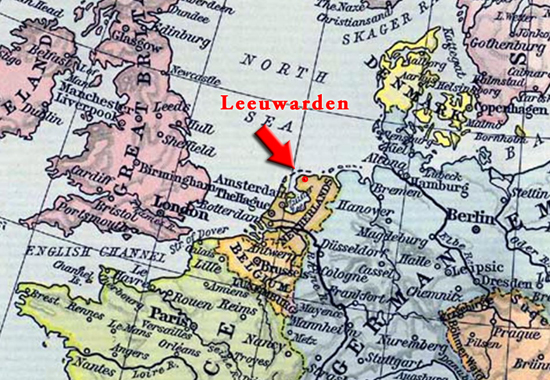
Map Location
of Leeuwarden, Netherlands - Map of Europe in 1911
Click map to enlarge
Mata Hari's background was the
middle-class. Her father,
Adam Zelle, made a good living as a milliner
(he made hats.)
That is until his fortune went south.
Her
mother was Antje van der Meulen
and of Javanese descent. Margaretha was their only daughter
but there was at least one other sibling.
Mata Hari — The
History Background
When Mata Hari was born, fellow
Dutch countryman Vincent van Gogh
was 23 years old with still both ears intact.
At the time, the king
of her country was William III
and Holland's capital The Hague was full of
colonial soldiers on leave from the Dutch East Indies, one
of the overseas territories of the Netherlands until
December 1949, now Indonesia.
See also
 Governments of the Netherlands.
Governments of the Netherlands.
Holland
and The Netherlands are often used synonymously.
Mata Hari — The
Early Years
In January 1889, Adam Zelle went bankrupt.
On September 4, 1890, Adam and
Antje separated.
In May 1891, Margaretha's mother died.
The siblings were split up and 15-year old Margaretha
was given to relatives.
In November 1892, Margaretha went to attend a college
for teachers in
Leiden, Netherlands. She had to leave because of her affair with the headmaster.
Margaretha moved to The Hague to live with an uncle.
In March 1895, Margaretha
answered a personal ad in which an "Officer recently
returned from the Indies seeks affectionate young woman for
marriage". The officer in question was
Rudolph MacLeod,
aka John MacLeod, colonel in the Dutch Army, who was deployed in the Dutch
East Indies and on leave to visit home. His family was
Scottish, as the name suggests, and had settled in Holland.
On July 11, 1895, Margaretha
married Rudolph MacLeod. He was 19 years her senior. The two
settled in Amsterdam.
On January 30, 1897, Margaretha
gave birth to her first child, son Norman John.
In May 1897, the family moved with
Rudolph, who had his next assignment in Indonesia (Java and
Sumatra)
The MacLeod's lived abroad from
1897-1902.
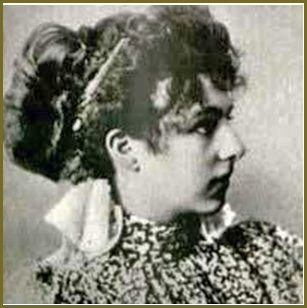
Mata Hari Before 1900
Source unknown
Mata Hari — The
Rudolph Disaster
Apparently, the man was able to
combine heavy drinking, gambling, and swearing with the occasional
fistfight. Additional points for beating the wife, being a
miser, and bringing home syphilis from the local brothel.
"Sometimes he jumps out at me with red,
bloodshot
eyes
and spits on me... I wanted to be
bitten by a snake
tonight
so I would not have to go back to
him."
Margaretha
MacLeod
Now Rudolph's
version, who was fed up with his wife's adultery . . .
"If I could deliver myself of this bitch I
would be happy.
Sometimes I cannot bear to
have this creature around me.
But what can I
do to get rid of her?"
Rudolph
MacLeod
On May 2, 1898,
and while still on Java, Margaretha gave birth to
her second child, daughter
Jeanne-Louise.
On June 25, 1899, both children
were poisoned, maybe by a lover of the
children's nurse, maybe not. Maybe not even poisoned at all.
Norman died, Jeanne-Louise survived. Another theory is that
Margaretha had contracted syphilis from her husband and that
she had passed it on to the baby.
In 1900, Rudolph quit the army.
In 1902, and back in Europe,
Rudolph and Margaretha separated. Daughter Jeanne-Louise
went with father Rudolph because he just took her.
In 1903, 26-year-old Margaretha
went to Paris. But without a job she couldn't
hang on. Back to the Netherlands, taking a deep
breath, and back to Paris, this time to stick.
Mata Hari —
Paris and Fame
Lady MacLeod,
the Javanese princess, was Margaretha's stage name and
character. She appeared in the drawing room of
Madame Kiréesky and others, and finally decided
to go by Mata Hari.
Her big break came
on May 13, 1905, at Guimet's theater, where she
performed completely, yet tastefully, in the
nudes. Erotic
dancing was a niche market, and that evening a
great success for Margaretha.
Together with other artists,
they slapped a show together, gave it a general
Hindu dance theme, and Mata Hari became a star.

Mata Hari notwithstanding the occasional Greek
stage decor
Mata Hari,
Paris, Museum Guimet/WIKI
The show got booked, the
ensemble went on tour, and audiences in Paris,
Brussels, London, Madrid, Berlin, the Hague, Vienna, Cairo and
other major cities were fascinated.
Mata Hari's
imagination grew proportional to the speed with which her fame increased.
"I was born in
Java, in the midst of tropical vegetation, and,
since my earliest childhood, priests initiated me into the
deep significance of these dances which form a real
religion."
Mata Hari
And why not. The
more exotic the better. The press ran with
it, Mata Hari's background changed and developed,
people loved it, no questions asked because,
let's face it, nobody really watched her show
for the articles.
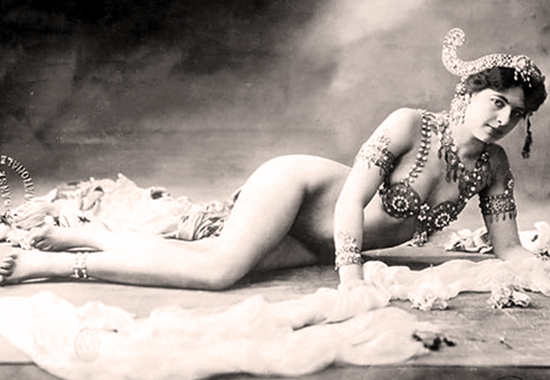
Less is More: Mata Hari
Featuring Jewelry, 1906
Source unknown
The legal separation from MacLeod, by the way, came in 1906.
Mata Hari was now officially divorced.
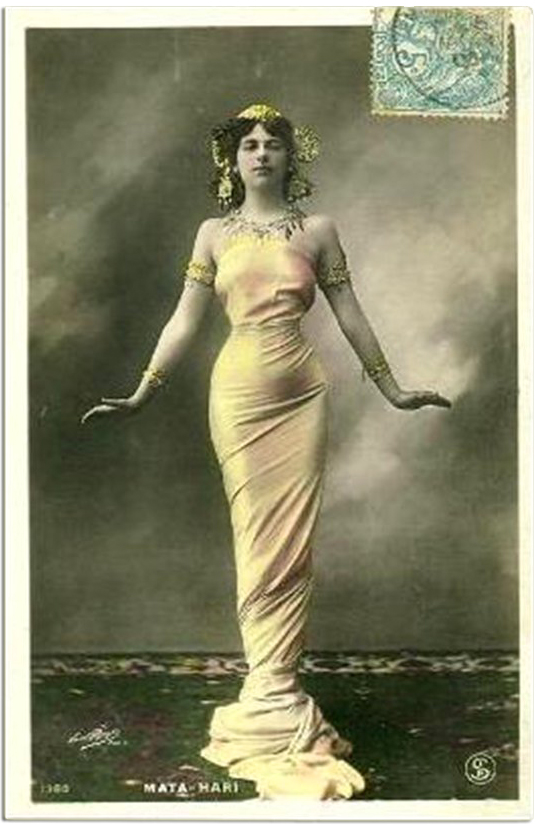
Mata Hari
Postcard, Paris 1906
Source unknown
Mata Hari —
The Spy Years
All went downhill for Mata Hari
when in 1914
 WWI broke out.
WWI broke out.
The events might have happened like this:
She was performing in Germany at the time
and the Germans took the opportunity to confiscate her
fortune and sent her off with nothing. Mata Hari went back
to Amsterdam and had a chat with the German consul there,
Consul Krämer.
It was there when they settled
on a bargain, a bargain that actually might or might not
have been offered or agreed upon: Her stuff back in return
for some spying activity.
Either this happened or she was just anywhere
in Europe and simply needed
money. She then was offered a good sum in exchange for
information.
Let's say something like this actually happened. Then it
would be also reasonable to believe that the French authorities approached Mata Hari
and asked her
to counter-spy for the Allies.
At this point, any of the
following scenarios could haven been true. Mata Hari could
have been
a) loyal to
the German cause (spy)
b) loyal to
the Allies (spy)
c) pretended
to be loyal to the Allies, but liked the
Germans best (double agent)
d) pretended
to be loyal to the German cause, when in
fact she double crossed them and was loyal
to the Allies all along (double agent)
e) used by
the Germans who let her believe she worked
for the French, when in fact she played
right into German hands (framed spy)
f) convinced
that she
was spying for the Germans but her memos
ended up on French desks (framed spy)
g) shifting
loyalty from any option to any other option
above (flexible spy)
h) approached and asked to spy for whatever
country, but was not willing or able to
deliver, hence didn't have to choose sides
(no spy at all, just a dancer)
i) approached
and asked to spy and she agreed in order to save
her hide. Whoever country asked her at any one
given moment, she would answer in a fashion
that would permit her to live to dance
another day. (dancer with a spy-store
shopping bag in her hand that was given to
her)
Mata Hari might or might not
have been Agent H 21.
Today, the French still insist that she was.
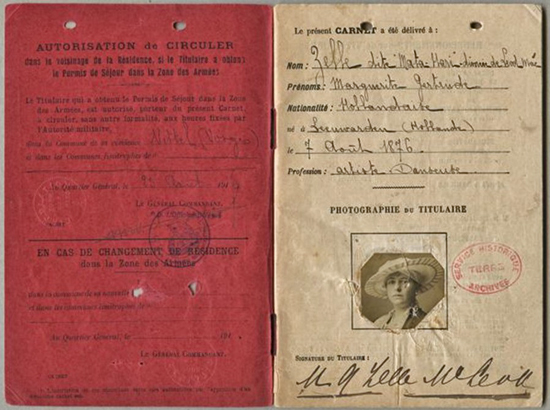
Mata Hari's
Passport
Ministère de la Défense
In any event...
Somehow Mata Hari wiggled her
way through the first three years of World War One. In
January 1917 she returned to Paris.
On February 13,
1917, the French Secret Service arrested her in
Paris at the Hotel Elysee Palace. She was accused of spying for
the enemy, and imprisoned at Saint-Lazarre, a
prison for women.
Brought before a military court on July 24
and 25, 1917, in Paris, the verdict was death by
firing squad.
On August 18, 1917, the New
York Times reports:
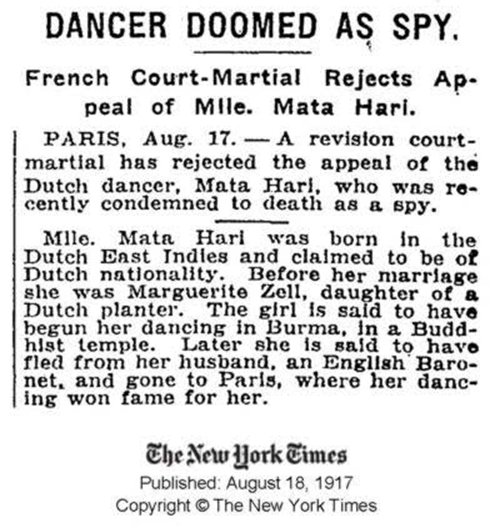
Mata Hari was executed on October 15,
1917, at the firing range of Vincennes, near Paris, France.
Check
 this event in the Timeline of World
War One.
this event in the Timeline of World
War One.
Nobody came to claim her body, so it was donated for medical
research.
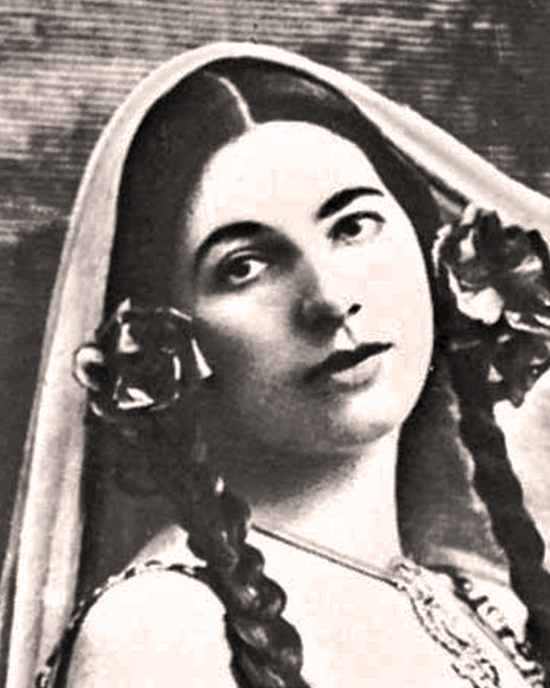
Mata
Hari Close-Up
Harlinque/H. Roger-Viollet
Did She or Didn't
She?
So, was Mata Hari a spy or not?
And if yes, for whom?
Good question. Many of her lovers were military officers
and she had easy access to high-society. She was certainly attractive to recruiters.
It seems at this point, however,
that there is no conclusive evidence to either prove or
disprove the fact that Mata Hari was a spy, let alone a
double agent.
But if she didn't leave
incriminating evidence behind, wouldn't that make her the
perfect spy?
Yes. Definitely maybe.
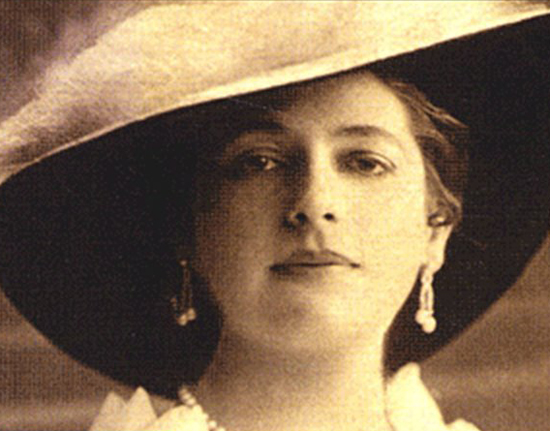
Mata Hari
Bundesarchiv
The British and
the French Archives Today
Here is a
 BBC article about Mata Hari's MI5 encounters.
BBC article about Mata Hari's MI5 encounters.
If you are ready to dig into the archives of the French secret service,
they will actually let you. At least the dossier that they got
prepared for tourists. Look for File
GR/9JJ/968 for all things Mata Hari.
By the way, what's today's official
French comment regarding Mata Hari? Was she or wasn't she?
If she was, the
insignificance of the information she was able to deliver now
seems proven. The record suggests that Mata Hari was somewhat
mundane, financially struggling, very naive about the realities
of espionage, trapped by a subtle interplay between law against
French and German espionage and overwhelmed by the sequence of
events which lead to the firing squad.
The French
But then again, wouldn't a really good
spy have you believe just that?
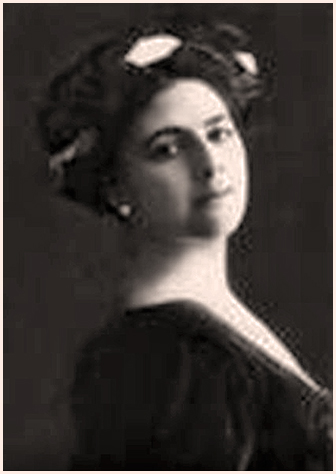
Mata Hari 1910
Bundesarchiv
And finally, what's Leeuwarden's
(Mata Hari's hometown's) comment?
Evert Kramer, custodian of a large
collection of Mata Hari memorabilia at the Fries Museum in
Leeuwarden, in an article by John Lichfield, NZ Herald:
She was clearly
guilty. She did spy for the Germans, that is certain. She also
made several offers to spy for the French.
Until all the Mata
Hari papers are declassified by the French government in 2017,
we cannot know the full truth.
Even then, I doubt
whether the full story will be revealed.
More History
|